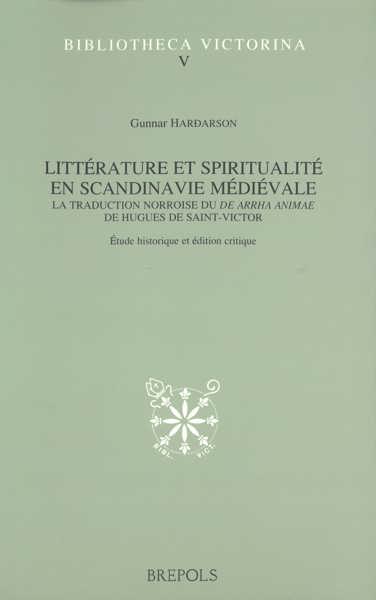
Littérature et spiritualité en Scandinavie médiévale
La traduction norroise du 'De arrha animae' de Hugues de Saint-Victor
G. Hardarson
- Pages: 284 p.
- Size:160 x 245 mm
- Language(s):French
- Publication Year:1995
- € 30,00 EXCL. VAT RETAIL PRICE
- ISBN: 978-2-503-50315-8
- Paperback
- Available
Although Victorine influence in Scandinavia has already received a certain amount of scholarly attention, this is the first study consecrated to the Old Norse-Icelandic translation of De arrha animae, a spiritual work of Hugh of Saint-Victor. This translation is preserved in three Icelandic manuscripts from the fourteenth and fifteenth centuries.
The first part of the book examines the translation and its context, particularly in connection with the transmission of Victorine thought and spirituality. Retracing Scandinavian ecclesiastical history, Victorine influence is seen to have been of particular importance in the Norwegian ecclesiastical milieu of the twelfth century and also to some extent in the milieu of the Norwegian royal court in the thirteenth century. An examination of the manuscript tradition allows the manuscript of the translation to be connected with other manuscripts containing texts written for the Norwegian court during the thirteenth century. Even if the translation respects the main divisions of the original Latin text, it is interspersed with interpolations and glosses that modify to some extent the content of the original. An examination of the vocabulary of the translation reveals unexpected juridical connotations and, in addition, brings out affinities with other Old Norse texts, original texts as well as translations, such as Agrip, Barlaams ok Josaphats saga and the Konungs skuggsjá or Speculum regale. In order to deepen the reader's appreciation of the literary and social background of the translation, the life and works of the Icelandic magistrate Haukr Erlendsson are examined against the background of the cultural history of thirteenth century Norway. Haukr Erlendsson made himself a career at the Norwegian court in the beginning of the fourteenth century, and it is to him that we owe the principal manuscript of the translation.
The second part consists of a critical edition of the Old Norse text accompanied by a Latin text prepared by the Hugo-von-Sankt-Viktor-Institut at Frankfurt. The epilogue of the Old Norse translation is included in an appendix. This epilogue contains passages which are apparently borrowed from the Didascalion of Hugh of Saint-Victor. The appendix also includes a letter addressed by the Victorine archbishop Thórir to a number of Icelandic chieftains in 1211, among them the celebrated poet and historian Snorri Sturluson, author of the Edda and of Heimskringla.
Si l'influence victorine en Scandinavie a déjà reçu l'attention des chercheurs, voici la première étude consacrée à la traduction norroise (ancien-norvégienne / ancien-islandaise) d'un opuscule spirituel de Hugues de Saint-Victor, le De arrha animae, conservée dans trois manuscrits islandais du 14e et 15e siècles. Dans la première partie du livre, l'auteur se consacre à l'étude de la traduction et de son contexte du point de vue de la transmission de la pensée et de la spiritualité victorine. Retraçant d'abord les grandes lignes de l'histoire ecclésiastique scandinave, il détermine les manifestations de l'influence victorine dans le milieu ecclésiastique du 12e siècle et dans le milieu royal du 13e siècle. L'examen de la tradition manuscrite permet de rapprocher les manuscrits de la traduction à d'autres manuscrits contenant des textes écrits pour la cour norvégienne au 13e siècle. Si la traduction, bien que souvent condensée, respecte les grandes divisions du texte latin, elle se trouve entrecoupée d'interpolations et de gloses, modifiant dans certains aspects le contenu de l'original. L'examen du vocabulaire de la traduction révèle des connotations juridiques inattendues et montre en outre des affinités avec d'autres textes norrois, traduits et originaux, comme l'Agrip, la Barlaams ok Josaphats saga, et le Konungs skuggsjá ou Speculum regale. Sur le fond du mouvement culturel dans la monarchie norvégienne du 13e siècle, qui englobe également la vie et l'oeuvre du magistrat islandais Haukur Erlendsson qui fit carrière à la cour norvégienne au début du 14e siècle et auquel on doit le manuscrit principal de la traduction, l'étude du contexte littéraire et social de la traduction est développée et approfondie. Dans la seconde partie on trouve l'édition critique de la traduction norroise, accompagnée d'un texte latin semi-critique préparé par le 'Hugo-von-Sankt-Viktor-Institut' à Francfort. En appendice sont publiés l'épilogue de la traduction norroise, comportant des passages empruntés au Didascalicon de Hugues de Saint-Victor et une lettre que l'archevêque victorin Thore adressa à quelques chefs islandais en 1211 parmi lesquels figure le célèbre poète et historien Snorri Sturluson, auteur de l'Edda et de la Heimskringla.




